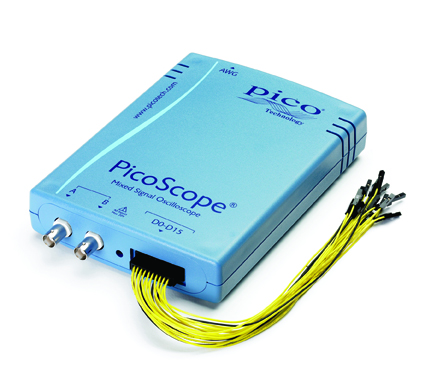 Wilt
u analoge en digitale signalen tegelijkertijd meter dan is
de 2205MSO de scope voor u. Wilt
u analoge en digitale signalen tegelijkertijd meter dan is
de 2205MSO de scope voor u.
•2 analogue
channels
•16 digital channels
•Measure analogue
signals up to 25 MHz
•Measure digital signals up to 100
MHz
•200 MS/s mixed–signal sampling
•Built–in function
generator and arbitrary waveform generator
•USB–powered
With the PicoScope 2205 mixed–Signal Oscilloscope (MSO)
it is possible for you to measure both analogue and digital
signals at the same time, using one device, and view the
analogue waveforms and digital data on the same screen.
The ultimate test and measurement laboratory
Your PicoScope 2205 MSO is more than a just another
instrument — it’s the ultimate test and measurement
laboratory. You can use your PicoScope 2205 MSO as a
dual–channel oscilloscope, a logic analyzer, a spectrum
analyzer, a function generator and an arbitrary waveform
generator. Five professional–quality instruments in one
compact, low–cost, USB–powered unit.
Use
it as an oscilloscope
With 25 MHz analogue
bandwidth, 200 MS/s real–time sampling and a 48 kilosample
buffer your PicoScope 2205 MSO is a powerful 8–bit,
two–channel USB oscilloscope that is suitable for circuit
design, testing and troubleshooting.
This
full–featured oscilloscope offers mask limit testing, maths
and reference channels, advanced digital triggering, serial
decoding, automatic measurements and color persistence
display.
Use it as a logic analyzer
The 16 digital inputs of your PicoScope 2205 MSO can be
displayed individually or in arbitrary groups labeled with
binary, decimal or hexadecimal values. A separate logic
threshold from -5 V to +5 V can be defined for each 8–bit
input port. The digital trigger can be activated by any bit
pattern combined with an optional transition on any input.
Advanced logic triggers can be set on either the analogue or
digital input channels, or both to enable complex
mixed–signal triggering.
U kunt de Pico 2205
MSO gebruiken als...
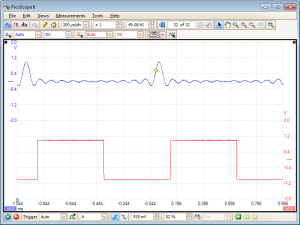
...een osciloscoop |
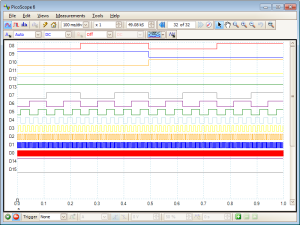
...een logic analyser |
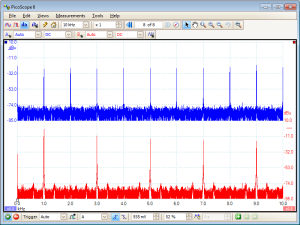
... een spectrum analyser |
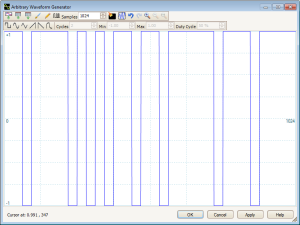
...een functiegenerator met AWG
|
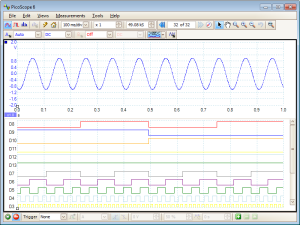
...een mixed-signal scope |
|
|
Why pay more?
At Pico we don’t do
“optional extras”. Other companies may think that you should
pay for high–end features such as mask limit testing, serial
decoding, advanced triggering, automatic measurements, math
channels, XY mode, digital filtering and segmented memory.
We don’t. When you buy a PicoScope USB mixed–Signal
Oscilloscope everything is included in the price.
For today, tomorrow and the future
With many companies once you’ve purchased your product
that’s the end of your relationship. When you purchase your
PicoScope that’s only the beginning of your relationship
with us. We want to make sure your PicoScope continues to
meet your needs for a long time to come. To do this we
regularly update our software with new features and
improvements — many suggested by you, our customers, and all
designed to let you get more from your scope. At the same
time we’ve made sure our PicoScope software can be used with
all of our standard PC oscilloscopes so if you ever want to
upgrade you don’t need to learn a new software package.
Many of our customers become lifelong PicoScope users.
We hope you’ll be one of them.
The
mixed–signal oscilloscope that you need
The
ability to measure two analogue signals of up to 25 MHz
together with 16 digital signals of up to 100 MHz, combined
with a 200 MS/s sampling rate and 48 kS buffer memory makes
the PicoScope 2205 MSO a powerful mixed–signal oscilloscope.
The compact, USB–powered design means that this is one
mixed–signal oscilloscope that can be used both on your
desktop or in the field. While the ability to also use it as
spectrum analyzer, function generator and arbitrary waveform
generator gives you a complete test and measurement lab at a
price you can afford.
If you want to measure both
analogue and digital signals then the PicoScope 2205 MSO is
the mixed–signal oscilloscope that you need.
What do I get?
•PicoScope 2205 MSO
•2
oscilloscope probes (x1/x10)#
•Protective case for scope
probes#
•Digital cable#
•2 packs of 10 test clips#
•USB cable
•User manuals
•PicoScope oscilloscope
software
•Free software updates
•5 year warranty
# Supplied if purchased as an oscilloscope kit.
|
Oscilloscope — Vertical (analogue
channels) |
|
Bandwidth |
25 MHz |
|
Rise time (calculated) |
14 ns |
|
Input channels |
2 |
|
Vertical resolution |
8 bits |
|
Enhanced vertical resolution |
12 bits |
|
DC accuracy |
±3% of full scale |
|
Input characteristics |
1 MΩ ±1% in parallel with 14 pF ±2 pF |
|
Input type |
Single–ended, BNC connector |
|
Input coupling |
Software selectable AC/DC |
|
Input sensitivity |
10 mV/div to 4 V/div (10 vertical
divisions) |
|
Input ranges (full scale) |
±50 mV to ±20 V in 9 ranges |
|
Overvoltage protection |
±100 V (DC+AC peak) |
|
Oscilloscope — Vertical (digital
channels) |
|
Number of channels |
16 (Port 0: D7–D0 and Port 1: D15–D8) |
|
Input connectors |
2.54 mm pitch 2–row connector, 20–way |
|
Maximum input frequency |
100 MHz |
|
Input impedance (with
ta136 cable) |
200 kΩ ±2% in parallel with 8 pF ± 2 pF |
|
Digital threshold range |
±5 V |
|
Input dynamic range |
±20 V |
|
Overvoltage protection |
±50 V |
|
Threshold grouping |
Two independent threshold controls
— Port 0: D7–D0 and Port
1: D15–D8 |
|
Threshold selection |
TTL,
CMOS,
ECL,
PECL, user–defined |
|
Threshold accuracy |
±100 mV |
|
minimum input voltage swing |
500 mV |
|
Channel–to–channel skew |
< 5 ns |
|
minimum input slew rate |
10 V/µs |
|
Oscilloscope — Horizontal |
Maximum sampling rate (single shot)
Ch A only
CH A + 1
digital port
1 or 2 digital ports
All
other combinations |
200 MS/s
200 MS/s
200 MS/s
100 MS /s |
|
Maximum equivalent sampling rate
(repetitive
signals) |
4 GS/s |
Maximum sampling rate
(continuous
streaming mode) |
10 MS/s on all scope channels and
digital ports in PicoScope 6
> 20 MS/s
using supplied
SDK
(PC dependent) |
|
Buffer memory |
48 kS shared between active channels and
ports |
|
Buffer memory (continuous streaming) |
100 MS using PicoScope software.
Up
to available PC memory when using supplied
SDK |
Waveform buffer
PicoScope (normal triggering)
PicoScope
(rapid triggering)
SDK |
10,000 software segments
32
hardware segments
32 hardware segments |
|
Timebase ranges |
2 ns to 5000 s/div |
|
Timebase accuracy |
±100 ppm |
|
Sample jitter |
< 300 ps
RMS |
|
Analogue Channels Dynamic Performance
(typical) |
|
Crosstalk (full bandwidth) |
Better than 200:1 (equal voltage ranges) |
|
Harmonic distortion |
< -55 dB at 100 kHz, full–scale input |
|
SFDR |
> 55 dB at 100 kHz, full–scale input |
|
Noise |
≤ 3 counts (all ranges) |
|
Linearity |
≤ 1
LSB |
|
Pulse response |
< 7% overshoot |
|
Bandwidth flatness (at scope input) |
(+0.3 dB, -3 dB) from DC to full
bandwidth |
|
Trigger (main features) |
|
Trigger modes |
None, auto, repeat, single, rapid
(segmented memory) |
|
Maximum pre–trigger capture |
100% of capture size |
|
Maximum post–trigger delay |
4 billion samples |
|
Trigger re–arm time |
< 2 µs on fastest timebase |
|
Maximum trigger rate |
32 waveforms in a 100 µs burst |
|
Trigger (analogue channels) |
|
Source |
Ch A, Ch B |
|
Trigger types |
Rising, falling |
|
Advanced triggers |
Edge, window, pulse width, window pulse
width, dropout, window dropout, interval,
runt pulse, logic |
|
Trigger sensitivity (Ch A, Ch B) |
Digital triggering provides 1 LSB
accuracy up to full bandwidth (ETS: typical
10 mV p–p at full bandwidth) |
|
Trigger (digital channels) |
|
Source |
D15 to D0 |
|
Trigger types |
Combined level and edge |
|
Advanced triggers |
Data pattern (can be grouped by user) |
|
Trigger (logic) |
|
Source |
Ch A, Ch B and D15 to D0 |
|
Trigger types |
Logic trigger across analogue and
digital inputs (using
“AND” and “OR”) |
|
Function Generator |
|
Standard output signals |
Sine, square, triangle, DC voltage,
ramp, sinc, Gaussian, half–sine |
|
Pseudorandom output signals |
White noise |
|
Standard signal frequency |
DC to 100 kHz |
|
Sweep modes |
Up, down, dual with selectable
start/stop frequencies and increments |
|
Output frequency resolution |
< 0.01 Hz |
|
Output voltage range |
±2 V |
|
Output voltage adjustment |
Signal amplitude and offset adjustable
in 1 mV steps within overall ±2 V range |
|
Amplitude flatness (typical) |
< 1 dB to 100 kHz |
|
DC accuracy |
±1% of full scale |
|
SFDR |
> 55 dB @ 1 kHz full–scale sine wave |
|
Connector type |
Rear panel BNC |
|
Output characteristics |
600 Ω |
|
Overvoltage protection |
±10 V |
|
Arbitrary Waveform Generator |
|
Update rate |
2 MS/s |
|
Buffer size |
8 kS |
|
Resolution |
12 bits |
|
Bandwidth |
100 kHz |
|
Rise time (10% to 90%) |
< 2 µs |
|
Buffer index mode |
Repeat |
|
Phase accumulator |
32 bits |
|
Output voltage range |
±2 V |
|
Spectrum Analyser |
|
Frequency range |
DC to 25 MHz |
|
Display modes |
Magnitude, peak hold, average |
|
Window types |
Rectangular, Gaussian, triangular,
Blackman, Blackman–Harris, Hamming, Hann,
flat–top |
|
Number of
FFT
points |
selectable from 128 to half
the available buffer memory in powers of 2 |
|
PC Requirements |
|
minimum |
Processor: 1 GHz
Memory: 512 miB
Free disk space: 32–bit: 600 MB,
64–bit: 1.5 GB
Operating system:
32– or 64–bit edition of microsoft Windows
XP (SP3), Vista, Windows 7 or Windows 8 (not
Windows RT)
Ports: USB
2.0 compliant port |
|
Recommended |
Processor: 1 GHz
Memory: 512 miB
Free disk space: 32–bit: 850 MB,
64–bit: 2 GB
Operating system:
32– or 64–bit edition of microsoft Windows
XP (SP3), Vista, Windows 7 or Windows 8 (not
Windows RT)
Ports: USB
2.0 or 3.0 compliant port |
|
Environmental |
Operating environment
Temperature range
Humidity range |
0 °C to 50 °C (20 °C to 30 °C for
stated accuracy)
5% to 80% RH,
non–condensing |
Storage environment
Temperature range
Humidity range |
-20 °C to +60 °C
5% to 95% RH,
non–condensing |
|
Physical Properties |
|
Dimensions (including connectors) |
200 x 140 x 40 mm
(approx 7.9 x 5.5
x 1.6 in) |
|
Weight |
<500 g (approx 17.6 oz) |
|
Software |
|
PicoScope 6 for Windows |
PicoScope 6 is your complete test and
measurement lab in one application. Features
include:
Capture modes:
oscilloscope, spectrum and persistence.
Channel maths: calculate the
sum, difference, product, inverse or create
your own custom function using standard
arithmetic, exponential and trigonometric
functions.
Mask limiting testing:
pass/fail, failure count, total count.
serial Decoding: decode data
from a serial bus such as I²C.
Automated measurements
Scope mode: AC
RMS,
true RMS, cycle time, DC average, duty
cycle, falling rate, fall time, frequency,
high pulse width, low pulse width, maximum,
minimum, peak–to–peak, rise time and rising
rate.
Spectrum mode:
frequency at peak, amplitude at peak,
average amplitude at peak, total power,
total harmonic distortion (THD % and THD
dB), total harmonic distortion plus noise
(THD+N), spurious-free dynamic range (SFDR),
signal+noise+distortion to signal+noise
ratio (SINAD), signal to noise ratio (SNR)
and intermodulation distortion (IMD).
Export data formats: comma
separated values (CSV), tab delimited (TXT),
windows bitmap (BMP), graphics interchange
format (GIF), portable network graphics
(PNG),
MATLAB 4 format (MAT).
Full details for PicoScope 6 |
|
Software development kit |
Includes drivers and example code for
various programming languages including C,
C#, Excel and LabVIEW.
Download SDK |
|
Language Support |
Software
PicoScope 6 |
Full support for:
English, Français, Deutsch, Italiano,
Español
Menus and dialogs only
for: 中文 (简体), 中文 (繁體), Čeština,
Dansk, suomi, Ελληνικά, Magyar, 한국어, 日本語,
Norsk, Polski, Português, română, Русский,
Svenska, Türkçe |
Documentation
User’s
guide
Programmer’s guide
Installation
guide |
English, Français,
Deutsch, Italiano, Español
English
English, Français, Deutsch, Italiano,
Español |
|
General |
|
Data sheet |
English,
中文 (简体),
Deutsch,
Español,
Français,
Italiano |
|
Additional hardware (supplied) |
USB 2.0 cable, user manuals, software
CD–ROM |
|
PC interface |
USB 2.0 (USB 1.1 compatible) |
|
Power requirements |
Powered from USB port |
|
Safety approvals |
Designed to EN 61010–1:2010 |
EMC approvals
CE
FCC |
Tested to EN61326–1:2006
Tested
to part 15 subpart B |
|
Environmental approvals |
RoHS and
WEEE compliant |
|
Warranty |
5 years |
|
|
 Wilt
u analoge en digitale signalen tegelijkertijd meter dan is
de 2205MSO de scope voor u.
Wilt
u analoge en digitale signalen tegelijkertijd meter dan is
de 2205MSO de scope voor u.




